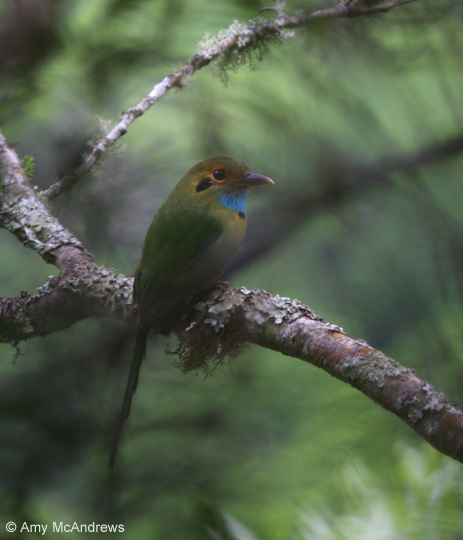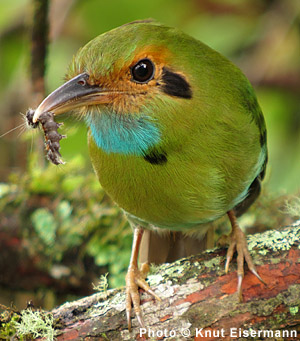
Aspatha gularis
TAXONOMY
Prionites gularis Lafresnaye, 1840, Guatemala. Monotypic.
OTHER COMMON NAMES
French: Motmot а gorge bleue; German: Blaukehlmotmot;
Spanish: Momoto Gorgiazul.
PHYSICAL CHARACTERISTICS
2.0–2.3 oz (56–65 g), 11 in (28 cm). Side of head is ochrecolored,
with a black spot behind eye. Green above and paler
green below, with dark green tail. Blue throat with black spot
on chest and blackish bill.
DISTRIBUTION
Mountains of southern Mexico to El Salvador. Overlaps the
same geographic range as several other motmots but lives at
higher altitudes.
HABITAT
Montane evergreen forest; 4,900–10,000 ft (1,500–3,100 m).
BEHAVIOR
Appears solitary, but seems to maintain pair bonds during and
between years. They are not very active, often go undetected.
Tail often pendulates, sometimes jerkily. They are inactive at
night, active at twilight at dawn and dusk. The blue-throated
motmot sings at daybreak after leaving its earth hole; its song
consists of pure full tones that rise and fall.
FEEDING ECOLOGY AND DIET
Insects are seized in flight by sallying; beetles make up a high
proportion of the diet. Fruits are also consumed.
REPRODUCTIVE BIOLOGY
In Guatemalan highlands, motmots dig holes soon after young
are fledged in late June or July. Pair spends nights in the hole
during rainy season and dry winter months. In April the female
lays 3–4 white eggs. After an incubation of 21–22 days, parents
keep young warm for a considerable period. Young do not return
to the nest hole at night after fledging.
CONSERVATION STATUS
Not threatened.
SIGNIFICANCE TO HUMANS
None known.
Photo Gallery of - Blue-throated motmot




 Animalia Life
Animalia Life